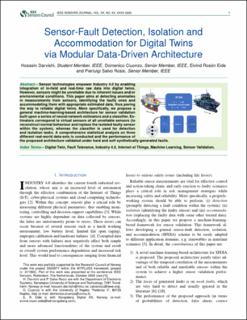| dc.contributor.author | Darvishi, Hossein | |
| dc.contributor.author | Ciuonzo, Domenico | |
| dc.contributor.author | Eide, Eivind R. | |
| dc.contributor.author | Salvo Rossi, Pierluigi | |
| dc.date.accessioned | 2022-10-07T11:22:36Z | |
| dc.date.available | 2022-10-07T11:22:36Z | |
| dc.date.created | 2020-10-08T12:24:12Z | |
| dc.date.issued | 2021 | |
| dc.identifier.citation | IEEE Sensors Journal. 2021, 21 (4), 4827-4838. | en_US |
| dc.identifier.issn | 1530-437X | |
| dc.identifier.uri | https://hdl.handle.net/11250/3024491 | |
| dc.description.abstract | Sensor technologies empower Industry 4.0 by enabling integration of in-field and real-time raw data into digital twins. However, sensors might be unreliable due to inherent issues and/or environmental conditions. This article aims at detecting anomalies in measurements from sensors, identifying the faulty ones and accommodating them with appropriate estimated data, thus paving the way to reliable digital twins. More specifically, we propose a general machine-learning-based architecture for sensor validation built upon a series of neural-network estimators and a classifier. Estimators correspond to virtual sensors of all unreliable sensors (to reconstruct normal behaviour and replace the isolated faulty sensor within the system), whereas the classifier is used for detection and isolation tasks. A comprehensive statistical analysis on three different real-world data-sets is conducted and the performance of the proposed architecture validated under hard and soft synthetically-generated faults. | en_US |
| dc.language.iso | eng | en_US |
| dc.publisher | Institute of Electrical and Electronics Engineers (IEEE) | en_US |
| dc.title | Sensor-Fault Detection, Isolation and Accommodation for Digital Twins via Modular Data-Driven Architecture | en_US |
| dc.type | Peer reviewed | en_US |
| dc.type | Journal article | en_US |
| dc.description.version | acceptedVersion | en_US |
| dc.rights.holder | © IEEE. Personal use of this material is permitted. Permission from IEEE must be obtained for all other uses, in any current or future media, including reprinting/republishing this material for advertising or promotional purposes, creating new collective works, for resale or redistribution to servers or lists, or reuse of any copyrighted component of this work in other works. | en_US |
| dc.source.pagenumber | 4827-4838 | en_US |
| dc.source.volume | 21 | en_US |
| dc.source.journal | IEEE Sensors Journal | en_US |
| dc.source.issue | 4 | en_US |
| dc.identifier.doi | 10.1109/JSEN.2020.3029459 | |
| dc.identifier.cristin | 1838187 | |
| cristin.ispublished | false | |
| cristin.fulltext | postprint | |
| cristin.qualitycode | 2 | |
